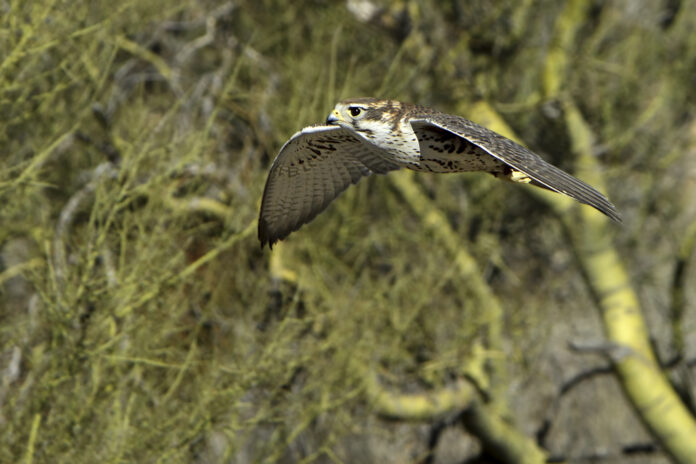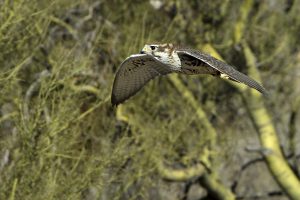
BY HARRY WEEKES

The human mind is astonishing.
At the end of November I was on what turned out to be a pretty perfect road trip—taking my youngest daughter to and from Bozeman for a hockey tournament. Just outside of Arco, we were on Highway 20 passing the Four Winds Café when I noticed a bump on top of a utility pole. We had already loaded our trip into eBird and were actively logging sightings along the way.
“Ooooh, what is that?” I said in my now characteristic early-warning-system voice. Penelope, it turns out, is a birding ninja. She established this outside of Picabo when she looked north and said, “trumpeter swans,” picking North America’s largest duck out of a sky that was literally the color of trumpeter swans with what I call “Game of Thrones Snow” falling—that snow that is big atmospheric flakes that don’t seem to either accumulate or bother anyone.
Penelope picked up the bird on the pole right away.
Then we shot past it going 70.
“Speckled chest, brown back,” she said.
“What was that?” I asked, at once voicing two things: first, that I didn’t know what it was; and second—and this is the human-mind part—that this bird seemed a bit different, somehow.
Birders often refer to GISS—the General Impression of Size and Shape—that one gets the moment you see a bird (or anything, for that matter). This is that very first sense, that inkling that is much more emotional than intellectual. The goal is to respond to the part of our brain that identifies something almost instantly. This sense can lead to specifics: “robin,” and the bird is a robin. Or it can be much vaguer: “Hmmm, that is different.”
Zipping by the post, my GISS-dar kicked in. “Should we stop?” My voice was tentative; we had a game to get to.
“Yes.” Remember, Penelope is a ninja.
Big U-turn. Then we were close enough to expand on the markings; pretty uniformly brown, with similarly uniform speckling on a buff chest. And something that looked like tears or even a moustache. Moustache? Wait a minute.
Somehow our minds store vast categories of information that exist like an enormous board of dominoes—disparate, discrete, yet potentially connected by the slightest tipping.
The dominoes: Speckled bird. Utility pole. Agricultural lands. Raptor. Southcentral Idaho. The tip: Moustache. Birds of prey with moustaches. Falcons have moustaches.
“It’s a prairie falcon!”
And the bird leaned forward and took off across the field.
Chasing birds can be like chasing your mind—watching your thoughts flit in and out, or your attention wander. It is building up a repertoire of experiences, each with individual significance, and also with the power to become something else. There is immediacy and patience; the known and the unknown; the constant and the fleeting. Reflecting is perhaps one of our greatest mental attributes.
Of course, reflection would, necessarily, have to wait. We had to get to Bozeman.


